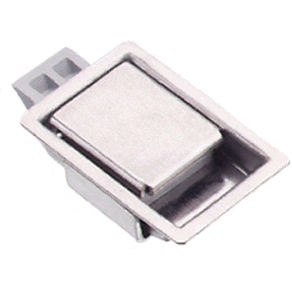
When shopping for latches, you may come across paddle latches. They are commonly used on doors, cabinets, access panels, toolboxes, lids and other objects. Like other types of latches, they allow you to open and close the objects on which they are mounted. Paddle latches, however, stand out for their simplicity and ease of use.
What Are Paddle Latches?
Paddle latches are cam-based latching mechanisms. They are characterized by a paddle-like handle after which they are named. As shown in the photo above, paddle latches have a rectangular, paddle-shaped handle within a housing unit.
Most paddle latches are flush-mounted. In other words, they don’t protrude from the surface of the object on which they are mounted. Instead, paddle latches lie flush with the object’s surface.
How Paddle Latches Work
There are different types of paddle latches, many of which have a spring-loaded design. They feature a compression spring that pushes against the latching mechanism. When you push the door or object closed, the latching mechanism will snap into the strike plate or frame.
You can open doors or objects on which paddle latches are mounted simply by pulling the handle. All paddle latches have a paddle-shaped handle. It’s found within the housing unit. Pulling the handle will release the latching mechanism from the strike plate or frame, allowing you to open the door or object.
Benefits of Paddle Latches
Why should you choose a paddle latch over other types of latches? One of the main benefits of paddle latches is their simple design. They feature a basic — typically spring-loaded — latching mechanism that requires nothing more than pulling or pushing. And with their simple design, paddle latches are long-lasting and require little or no maintenance.
You can find paddle latches in different materials, such as steel, aluminum and various zinc-plated alloys. These materials ensure paddle latches are durable and able to withstand repeated use.
Another benefit of paddle latches is their low-profile design. They sit flush with the surface of the door or object on which they are mounted. Not only does this enhance their aesthetics; it makes them to safe to use. Other types of patches may protrude out of objects, which can pose an injury to workers. Paddle latches lie flush, though, to protect workers and other individuals from injury.
You can also find paddle latches in locking and non-locking styles. Locking paddle latches, of course, have a locking mechanism. They are commonly used to protect valuable equipment and prevent unauthorized access.
